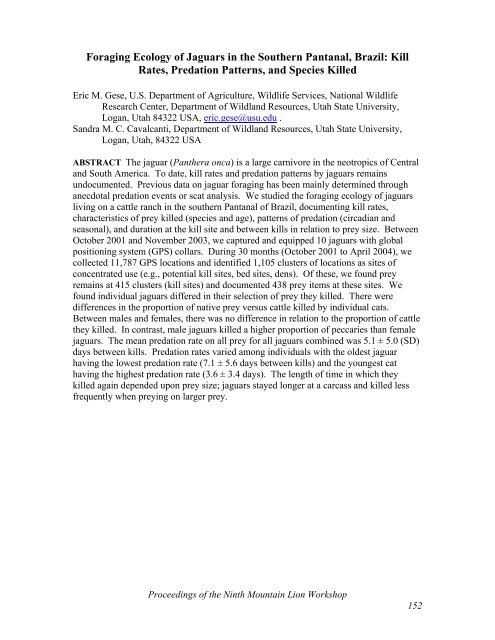Proceedings of the Ninth Mountain Lion Workshop - Carnivore ...
Proceedings of the Ninth Mountain Lion Workshop - Carnivore ...
Proceedings of the Ninth Mountain Lion Workshop - Carnivore ...
You also want an ePaper? Increase the reach of your titles
YUMPU automatically turns print PDFs into web optimized ePapers that Google loves.
Foraging Ecology <strong>of</strong> Jaguars in <strong>the</strong> Sou<strong>the</strong>rn Pantanal, Brazil: Kill<br />
Rates, Predation Patterns, and Species Killed<br />
Eric M. Gese, U.S. Department <strong>of</strong> Agriculture, Wildlife Services, National Wildlife<br />
Research Center, Department <strong>of</strong> Wildland Resources, Utah State University,<br />
Logan, Utah 84322 USA, eric.gese@usu.edu .<br />
Sandra M. C. Cavalcanti, Department <strong>of</strong> Wildland Resources, Utah State University,<br />
Logan, Utah, 84322 USA<br />
ABSTRACT The jaguar (Pan<strong>the</strong>ra onca) is a large carnivore in <strong>the</strong> neotropics <strong>of</strong> Central<br />
and South America. To date, kill rates and predation patterns by jaguars remains<br />
undocumented. Previous data on jaguar foraging has been mainly determined through<br />
anecdotal predation events or scat analysis. We studied <strong>the</strong> foraging ecology <strong>of</strong> jaguars<br />
living on a cattle ranch in <strong>the</strong> sou<strong>the</strong>rn Pantanal <strong>of</strong> Brazil, documenting kill rates,<br />
characteristics <strong>of</strong> prey killed (species and age), patterns <strong>of</strong> predation (circadian and<br />
seasonal), and duration at <strong>the</strong> kill site and between kills in relation to prey size. Between<br />
October 2001 and November 2003, we captured and equipped 10 jaguars with global<br />
positioning system (GPS) collars. During 30 months (October 2001 to April 2004), we<br />
collected 11,787 GPS locations and identified 1,105 clusters <strong>of</strong> locations as sites <strong>of</strong><br />
concentrated use (e.g., potential kill sites, bed sites, dens). Of <strong>the</strong>se, we found prey<br />
remains at 415 clusters (kill sites) and documented 438 prey items at <strong>the</strong>se sites. We<br />
found individual jaguars differed in <strong>the</strong>ir selection <strong>of</strong> prey <strong>the</strong>y killed. There were<br />
differences in <strong>the</strong> proportion <strong>of</strong> native prey versus cattle killed by individual cats.<br />
Between males and females, <strong>the</strong>re was no difference in relation to <strong>the</strong> proportion <strong>of</strong> cattle<br />
<strong>the</strong>y killed. In contrast, male jaguars killed a higher proportion <strong>of</strong> peccaries than female<br />
jaguars. The mean predation rate on all prey for all jaguars combined was 5.1 ± 5.0 (SD)<br />
days between kills. Predation rates varied among individuals with <strong>the</strong> oldest jaguar<br />
having <strong>the</strong> lowest predation rate (7.1 ± 5.6 days between kills) and <strong>the</strong> youngest cat<br />
having <strong>the</strong> highest predation rate (3.6 ± 3.4 days). The length <strong>of</strong> time in which <strong>the</strong>y<br />
killed again depended upon prey size; jaguars stayed longer at a carcass and killed less<br />
frequently when preying on larger prey.<br />
<strong>Proceedings</strong> <strong>of</strong> <strong>the</strong> <strong>Ninth</strong> <strong>Mountain</strong> <strong>Lion</strong> <strong>Workshop</strong><br />
152
















